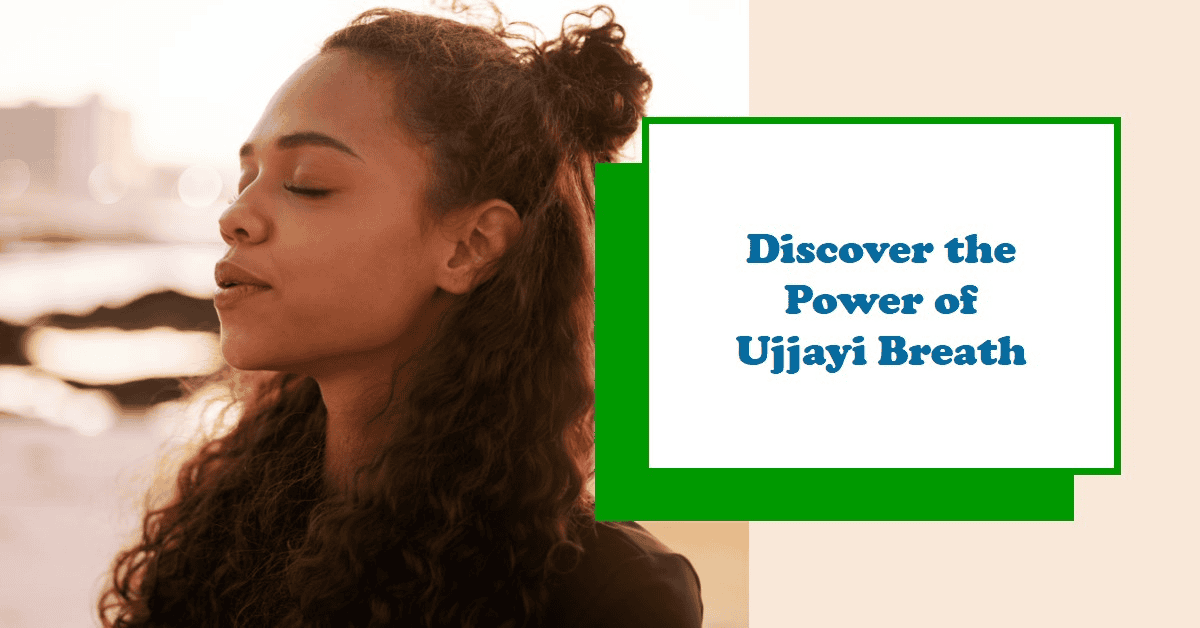Breathing is the most essential and natural process of human life. It is not only responsible for keeping us alive, but the way we breathe can have a profound impact on our overall well-being. Among various breathing techniques used in different practices, Ujjayi breath holds a unique and powerful position.
Ujjayi breath can bring several benefits such as:
- Increased oxygen intake
- Regulation of breathing and heart rate
- Improved concentration and focus
- Reduced stress and anxiety
- Cleansing of the respiratory system
- Strengthening of the diaphragm and lungs
- Increased awareness and mindfulness during yoga or meditation practice.
Also known as the “victorious breath” or “ocean breath,” this ancient yogic technique has the ability to rejuvenate the body and calm the mind, making it an excellent tool for relieving stress and enhancing self-awareness.
But what exactly is Ujjayi breath? How does it work? And, most importantly, what are the benefits that this controlled breathing method can offer to those who incorporate it into their daily routine or yoga practice?
In this blog post, we will explore all these questions and reveal the wonders of the Ujjayi breath technique as we take you on a journey towards a more mindful, balanced, and rewarding life experience. So light your favorite candle, roll out your yoga mat, and join us on this path of self-discovery and wellness.
Table of contents
Increased Internal Heat
One of the key benefits of practicing ujjayi breath is the increased internal heat it generates in the body. This ancient technique, rooted in yoga and mindfulness practices, involves constricting the muscles in the back of the throat to create an audible yet calming sound, often compared to the gentle sounds of ocean waves. As practitioners focus on taking slow, deep breaths through their nostrils, they are able to boost their core temperature, which can have a number of positive effects on both physical and mental well-being.
The increased internal heat from ujjayi breath can help to warm up the body, making it more limber and flexible for physical activities such as yoga, dance or sports. This gradual warming of muscles and joints can help to reduce the risk of injury, ensuring a safer and more beneficial workout. Additionally, the heat generated has been found to have a detoxifying effect on the internal organs, stimulating and cleansing them, further improving overall health.
Mentally, the warmth created through ujjayi breath can have a calming and soothing impact on the mind, allowing for increased focus, concentration, and a sense of emotional balance. This internal heat, coupled with the rhythmic nature of the breath, can also create a meditative state which can help to reduce stress and anxiety while boosting mood and promoting a sense of inner peace.
In summary, the increased internal heat generated through the practice of ujjayi breath can provide a range of physical and mental benefits, [1][2]
Digestive Stimulation
The practice of Ujjayi breath, a popular breathing technique in yoga, has been found to have numerous benefits on the body and mind. One such advantage is the stimulation of the digestive system. This ancient breathing technique involves the gentle constriction of the back of the throat while inhaling and exhaling deeply through the nostrils, producing a soothing ocean-like sound.
When practiced regularly, Ujjayi breath can significantly enhance the digestive process. The slow, rhythmic inhalation and exhalation encourage the diaphragm to move more effectively, promoting better circulation and oxygen flow through the abdominal region. This increased oxygen supply aids in the breaking down of food particles, enhancing nutrient absorption, and promoting healthy bowel movements.
Furthermore, the deep breathing involved in Ujjayi breath helps stimulate the vagus nerve, which runs through the throat, thorax, and abdomen. The vagus nerve plays a vital role in controlling the digestive system, as it sends signals between the brain and various organs, including the stomach and intestines. By stimulating the vagus nerve, Ujjayi breath can help regulate the digestive process and ensure optimal functioning.
Additionally, the calming effect of Ujjayi breath on the mind can help alleviate stress, which is known to negatively impact digestion. Stress can lead to an imbalance in the production of stomach acid, causing indigestion, bloating, and other digestive issues. [3][4]
Improved Focus and Concentration
One significant benefit of practicing Ujjayi breath is the improved focus and concentration that it offers. This ancient pranayama technique involves constricting the throat, which creates an audible sound as the air moves through the vocal cords. The resulting sound is often compared to the gentle waves of the ocean, which can have a soothing effect on the mind. By focusing on the sound of their breath, practitioners can achieve a greater sense of mental clarity and presence during their yoga practice.
The act of controlling one’s breath in this manner can help to quiet the mind and let go of distracting thoughts. This is particularly beneficial during yoga asanas or meditation practices, where concentration plays a vital role. The deep, slow breathing pattern encourages the practitioner to stay in the present moment, allowing for greater awareness of the sensations in their body and the movements of their practice.
Ujjayi breathing also offers the added benefit of linking the mind, body, and spirit. As practitioners become more aware of the connection between their breath and movements, they may find it easier to stay present and focused during their practice. This heightened sense of awareness can greatly enhance the overall yoga experience and lead to a deeper understanding of the mind-body connection.
In addition to its role in enhancing focus and concentration, Ujjayi breath has been known to improve overall cognitive function, helping practitioners to retain focus even outside of their yoga practice. [5][6]
Increased Endurance and Stamina
One of the many benefits of practicing ujjayi breath is the increased endurance and stamina it provides. This ancient pranayama technique has been used in yoga for centuries to boost energy levels, enabling practitioners to maintain steady and focused movement during their asana practice.
Incorporating ujjayi breath into a yoga routine not only strengthens the diaphragm but also improves respiratory efficiency, allowing for deeper and fuller breaths. This results in an increased supply of oxygen to the muscles, which in turn provides more energy for the body to use during physical activities. With greater endurance and stamina, yogis can hold poses for extended periods and move through challenging sequences with ease.
Moreover, practicing ujjayi breath regularly can help to keep the mind calm and focused, further enhancing one’s ability to maintain a steady and consistent pace during a yoga flow or other workout sessions. This connection between breath and movement adds another layer of richness and depth to one’s practice, contributing to a more enjoyable experience overall.
When combining ujjayi breath with asana practice, it’s essential to ensure that the practice is safe and appropriate. Learning proper technique from an experienced teacher and following guidelines for individual practice is vital for reaping the benefits of ujjayi breath without risking harm or injury.
In conclusion, incorporating ujjayi breath into one’s yoga routine can lead to increased endurance and stamina, contributing to a stronger and more stable practice overall. [7][8]
Encourages Relaxation and Reduces Tension
Ujjayi breath is known for its incredible capacity to encourage relaxation and reduce tension in the body and mind. This ancient yogic breathing technique, often referred to as the “ocean sounding breath,” works by constricting the throat slightly, allowing the breath to move in a steady, rhythmic pattern. As one practices this calming pranayama, it activates the vagus nerve, which in turn stimulates the “rest and renew” response or the parasympathetic nervous system.
The activation of the parasympathetic nervous system helps release muscular tension and ease mental stress. This can be particularly beneficial during challenging yoga poses or fast-paced flow. Incorporating the ujjayi breath while practicing yoga asanas helps individuals stay centered and focused, as it establishes and maintains a soothing rhythm for both the body and mind.
Moreover, the soft, wave-like sound created by ujjayi breath serves as an auditory anchor, keeping practitioners present and aware of their inner state. This heightened awareness promotes a deeper connection between the mind, body, and spirit, leading to a richer and more profound yoga practice.
In addition to its use in yoga, the ujjayi breath can be beneficial in everyday situations as well. Whenever one feels overwhelmed, anxious, or stressed, simply practicing this pranayama for a few minutes can bring a calming and relaxing effect.
In summary, the ujjayi breath offers a powerful tool for encouraging relaxation and reducing tension. [9][10]
Improved Respiratory Efficiency
Improved respiratory efficiency is one of the remarkable benefits of practicing Ujjayi breath, a yoga breathing technique that has gained popularity among practitioners of all levels. This technique, sometimes referred to as the “ocean breath,” is known for its soothing effects on the mind and the body, including an enhanced ability to breathe more effectively.
By practicing Ujjayi breath, individuals can experience an increase in their lung capacity and oxygen absorption. This is primarily due to the slow, deep, and deliberate nature of the breaths taken during Ujjayi practice. The technique encourages individuals to pay close attention to their inhalation and exhalation while maintaining a gentle constriction in the throat, resulting in soft, audible breaths that resemble the sound of ocean waves.
As the practitioner breathes in this controlled manner, their lungs can expand more fully, allowing oxygen to reach all cells within the lungs. This increased oxygen absorption not only enhances respiratory efficiency but also gives a gentle massage to the internal organs, promoting overall health and well-being.
Moreover, the practice of Ujjayi breath has been shown to reduce the need for more frequent breathing. Research has suggested that slow breathing rates, at around 5-6 breaths per minute, can result in increased vagal activation, leading to a reduction in sympathetic activation, heightened parasympathetic activation, and improved cardiac-vagal baroreflex sensitivity. This, in turn, contributes to better respiratory efficiency and greater control over one’s breathing patterns. [11][12]
Calming Effect on the Mind
One of the significant benefits of ujjayi breathing is its calming effect on the mind. This ancient yogic technique, often referred to as the “ocean-sounding breath,” helps practitioners find stillness and focus during their practice. By creating a soothing sound and regulating the flow of breath, ujjayi encourages the activation of the parasympathetic nervous system, also known as the “rest and renew” system.
When practicing ujjayi, individuals constrict their throat slightly, allowing less air to flow through and lengthening inhalations and exhalations. This controlled breathing not only improves oxygen saturation but also helps activate the vagus nerve, which plays a key role in regulating the body’s stress response. As a result, ujjayi breathing can lower blood pressure, slow the heart rate, and reduce anxiety levels.
Furthermore, by focusing on the sound and sensation of the breath while practicing ujjayi, yoga practitioners can enhance their concentration and become more present in the moment. This heightened awareness can lead to a deeper and more meaningful yoga practice, as well as contribute to the individual’s overall mental well-being.
In today’s fast-paced and often stressful world, finding techniques that cultivate calmness and clarity is essential for maintaining mental health. Ujjayi breathing, with its soothing sound and gentle regulation of breath, offers a valuable tool for fostering relaxation and mental focus. [13][14]
Balances Subtle Energy Channels
Practicing ujjayi breath can help in balancing the subtle energy channels in the body, thereby promoting overall well-being and harmony. In yoga, these subtle energy channels are known as nadis, which carry the life force energy, or prana, throughout the body. The primary nadi, Sushumna, runs along the spine, while the other two major nadis, Ida and Pingala, intersect with it at various points. When these channels are balanced, energy flows freely, and the individual experiences a state of equilibrium, inner peace, and health.
Ujjayi breath is a powerful technique to balance these energy channels, as it involves a slight constriction of the throat and lengthening of the breath. This controlled and deep breathing method not only helps regulate the flow of prana, but also stimulates and cleanses the nadis. As the breath passes through the constricted throat, it creates a gentle vibration that resonates through the cranial cavity, massaging and stimulating the subtle energy channels.
Furthermore, the rhythmic and focused nature of ujjayi breathing harmonizes the endocrine system and promotes a sense of mental and emotional stability. By consciously controlling the breath during ujjayi pranayama, practitioners can actively work towards balancing their energy channels and removing any blockages that may hinder the free flow of prana. This, in turn, has positive effects on overall health, mood, and well-being. [15][16]
Mood Enhancement
The practice of Ujjayi breathing has been found to offer several benefits, one of which is mood enhancement. This ancient pranayama technique is known for its warming, focusing, and energizing effects on the body and mind, which can help alleviate mild depression and elevate one’s overall emotional well-being. By incorporating Ujjayi breathing into their yoga routines, individuals can experience an increased sense of aliveness and positivity in their daily lives.
This mood-enhancing benefit can be attributed to the calming and balancing effects Ujjayi breathing has on the body’s nervous system. When practiced correctly, this form of pranayama encourages the release of muscular tension and activates the vagus nerve, which in turn activates the “rest and renew” or parasympathetic activity of the nervous system. This has been shown to promote overall relaxation, which can help to reduce stress, anxiety, and negative emotions.
Moreover, Ujjayi breathing helps to increase focus and concentration by connecting the body, mind, and spirit to the present moment. This enhanced mindfulness and presence allows individuals to shift their attention away from negative thoughts or emotions and cultivate a deeper, more positive connection with themselves and their environment.
Incorporating Ujjayi breathing into one’s yoga practice can thus serve as a powerful tool for mood enhancement and emotional regulation. As individuals become more adept at using this technique, they may find it easier to navigate through life’s challenges with a greater sense of calm. [17][18]
Relieves Sinus Pressure and Headaches
One of the lesser-known benefits of practicing Ujjayi breath is the relief it can provide from sinus pressure and headaches. This ancient breathing technique offers various physical, mental, and emotional benefits to those who include it in their yoga practice or daily routine. Apart from helping maintain focus, improve digestive health, and promote relaxation, Ujjayi breath has also been found to effectively alleviate sinus discomfort and headache symptoms.
The gentle vibrations generated by the Ujjayi breath technique have a direct impact on the nasal passages and sinuses. Consequently, these vibrations help open up the sinuses, clearing blockages and allowing for smoother airflow. Regular practice of Ujjayi breathing can significantly reduce sinus pressure and decrease the chances of developing headaches associated with it.
Moreover, Ujjayi breath can help improve overall respiratory health, as it encourages deep, controlled breathing, which in turn promotes better oxygen saturation and strengthens the respiratory system. This efficient breathing method can, therefore, prove to be of great value to those struggling with sinus issues and headaches.
In addition, the calming effects that Ujjayi breath has on the nervous system help reduce stress, which is a common trigger for headaches. As practicing Ujjayi breath helps you to stay present in the moment and maintain a meditative state, it becomes easier to let go of stress and prevent tension headaches from occurring.
In conclusion, incorporating Ujjayi breath into your daily routine can offer numerous advantages, including relief from sinus pressure and headaches. [19][20]




